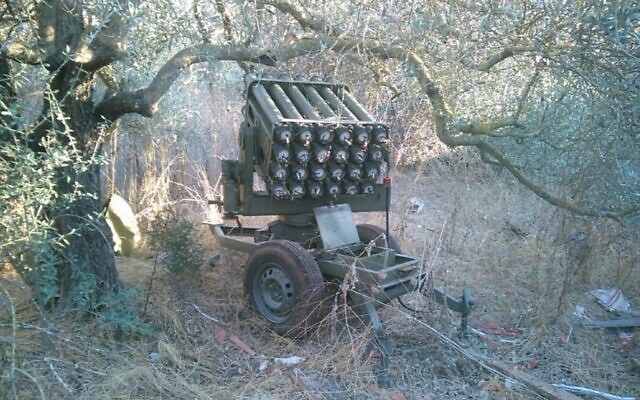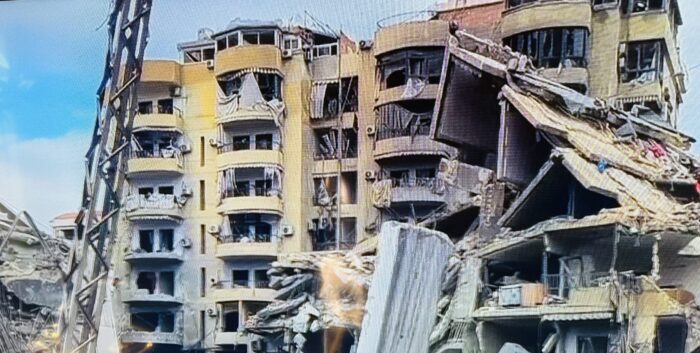A long-awaited ceasefire has finally ended the 415-day cross-border war in Lebanon pitting Israel against Hezbollah.
On November 26, the Israeli cabinet ratified it by a vote of 10-1, with only National Security Minister Itamar Ben-Gvir opposing it. He called for the creation of an Israeli security zone in southern Lebanon, but was overruled.
Shortly afterward, U.S. President Joe Biden announced that the truce would go into effect at 4 a.m. on November 27, less than two months before President-elect Donald Trump assumes office.
On the eve of the truce, Israel and Hezbollah took last-minute swipes at each other. Hezbollah fired rockets and drones into northern Israel. Israeli aircraft struck more than 300 Hezbollah targets, bombing its stronghold in the Beirut suburb of Dahiyeh and hitting its facilities in the Bekaa Valley. Among Israel’s targets was Hezbollah’s largest underground precision-guided missile manufacturing factory.

For the first time in 24 years, Israeli troops reached the Litani River, engaging Hezbollah fighters and destroying rocket launchers. The commander of Israeli troops in Lebanon, General Ori Gordin, was photographed standing on the shore of the river.
The 60-day ceasefire is based on United Nations Resolution 1701, which was passed following Israel’s 34-day war with Hezbollah in 2006. Under the terms of the current truce, Hezbollah will gradually withdraw to a line north of the Litani River, a distance of about 30 kilometers from the Israeli border, and Israel will pull out of southern Lebanon in incremental phases.
The Lebanese army and the United Nations Interim Force in Lebanon, which was created after Israel’s first invasion of Lebanon in 1978, are due to fill the vacuum. They will patrol the buffer zone, which Hezbollah had turned into an armed camp from which to attack Israel. No other armed group will be allowed into this area.
Biden, whose special envoy Amos Hochstein was largely instrumental in brokering the ceasefire, said it is designed to permanently end hostilities between Israel and Hezbollah. “What is left of Hezbollah and other terrorist organizations will not be allowed — I emphasize, will not be allowed — to threaten the security of Israel again,” Biden added.

The hope is that the ceasefire will work and lead to talks to demarcate Israel’s land border with Lebanon. Two years ago, Hochstein succeeded in defining their maritime border.
The United States and France will monitor and enforce the ceasefire in Lebanon, which had degenerated into a battleground between Iran and Israel, the strongest powers in the Middle East apart from Turkey.
A monitoring and enforcement mechanism will be necessary because Hezbollah, Iran’s chief proxy in the Middle East, blatantly violated Resolution 1701. Hezbollah built a formidable military infrastructure in villages and towns in southern Lebanon, which is inhabited mainly by Shi’a Muslims.
With that in mind, Prime Minister Benjamin Netanyahu said that the longevity of the truce is dependent on what happens on the ground in Lebanon. If Hezbollah violates the ceasefire, Israel will respond militarily. “With the full understanding of the United States, we are preserving full military freedom of action — if Hezbollah breaks the agreement and seeks to arm itself, we will attack.”
Netanyahu was referring to a side letter from the United States assuring Israel of its full support should it be forced to resume the war.
The letter leaves no stone unturned.
The U.S. will acquiesce to Israeli reconnaissance flights over Lebanon. The U.S. will provide Israel with intelligence information pertaining to ceasefire violations. The U.S. will inform Israel of attempts by Hezbollah to infiltrate the ranks of the Lebanese army. The U.S. will notify Israel of Iranian efforts to smuggle weapons to Hezbollah.
Previously, Hezbollah’s secretary general, Naim Qassem, had expressed opposition to any arrangement whereby Israel enjoyed freedom of action inside Lebanon.
Pundits in Israel speculated that Netanyahu agreed to a ceasefire out of concern that the Biden administration might withhold arms supplies or withdraw diplomatic support for Israel at the United Nations.
In a televised speech, Netanyahu cited three reasons for accepting a ceasefire. It will allow Israel to focus on Iran, Israel’s deadliest regional enemy. It will enable Israel to rebuild its depleted stockpile of weapons and munitions. And it will isolate Hezbollah’s ally, Hamas, in the Gaza Strip. As he put it, “Hamas relied on Hezbollah to fight by its side. With Hezbollah out of the picture, Hamas is now alone in the battle. Our pressure on them will grow.”
Hamas attacked southern Israel on October 7, 2023, killing about 1,200 people and kidnapping 250 Israelis and foreigners. By way of retaliation, the Israeli Air Force launched a relentless bombing campaign that has devastated Gaza.
Toward the close of October, Israel invaded Gaza with the intention of destroying Hamas’ military assets and capabilities and ensuring it will never rules Gaza again. By all accounts, Israel has seriously degraded Hamas, having eliminated 18,000 of its combatants, killed its leadership, blown up many of its tunnels, and destroyed its caches of weapons and munitions.
However, Hamas is far from dead, and 101 hostages, alive and dead, still remain in Gaza.
Hezbollah, in a tangible gesture of solidarity with Hamas, began firing rockets and drones at northern Israel on October 8. These attacks, combined with the fear that Hezbollah might launch an invasion of the Galilee, compelled Israel to evacuate some 60,000 Israelis living within a few kilometers of the Lebanese border.
At the fighting degenerated into a low-intensity war of attrition, about 90,000 Lebanese were evacuated from southern Lebanon.
Starting in mid-September, Israel escalated the war dramatically by disrupting Hezbollah’s command-and-control system by detonating thousands of pagers and personal radios belonging to its members. This was a spectacular blow to Hezbollah.
The Israeli Air Force, in precision strikes, decimated Hezbollah’s leadership and eradicated much of its offensive capabilities and infrastructure along the Lebanese border. These attacks weakened Hezbollah to a considerable degree.

On September 30 and October 1, the Israeli army stormed into southern Lebanon in its third invasion since 1982. Israel captured key terrain close to the border and destroyed military infrastructure, including tunnels, that had been built to facilitate a ground invasion of northern Israel.
The war, though limited in terms of scope and depth of penetration, has caused the deaths of 76 Israeli soldiers and 45 civilians.
Tactically, Israel’s objective was to destroy Hezbollah’s base in southern Lebanon, push Hezbollah beyond the Litani River, and facilitate the return of the displaced Israelis. The operation was not intended to destroy Hezbollah as a military organization.
An Israeli campaign to obliterate all of Hezbollah offensive capabilities, including its long and intermediate-range rockets, missiles, and drones, would have necessitated a far more ambitious military undertaking than the current operation.
Until Israel’s assassination of Hezbollah’s previous leader, Hassan Nasrallah, Hezbollah had opposed a ceasefire in Lebanon unless there was a corresponding one in Gaza. Israel categorically rejected this condition on the grounds that it would be advantageous to Hamas.
But after Nasrallah’s demise in September, Hezbollah dropped that condition, breaking the deadlock and enabling ceasefire negotiations to proceed. Iran, cognizant that Hezbollah has been battered, encouraged it to accept a ceasefire that respected Lebanon’s sovereignty and resulted in an eventual Israeli withdrawal from Lebanon.
It seems clear that Hezbollah altered its position due to Israel’s success in smashing its military infrastructure throughout Lebanon. By one estimate, Israel has destroyed 70 percent of its drones and 80 percent of its rockets.

Nonetheless, Israel failed to suppress Hezbollah’s ability to fire rockets and drones at Israel. By all accounts, Hezbollah has launched 17,000 rockets and drones toward Israel in the past year, causing damage to residential buildings and military bases.

Incredibly enough, Hezbollah claims to have won the war. However Hezbollah perceives the outcome, the war has been a disaster for Lebanon. Nearly 4,000 Lebanese civilians and up to 4,000 Hezbollah fighters have been reportedly killed. Twenty percent of the population has been displaced. Villages in southern Lebanon have been reduced to rubble. Neighborhoods in southern Beirut, Tyre, Sidon, Nabatieh and Baalbek have been severely damaged.

Beirut’s chamber of commerce estimates that Lebanon’s GDP will contract by around nine percent this year. The World Bank estimates that Lebanon’s direct economic losses will be in the vicinity of $8.5 billion. The Lebanese economy minister claims that the cost of the war will reach $20 billion.
The war has led to criticism of Hezbollah, particularly among Christians. They are incensed that Hezbollah, in the service of Iran, dragged Lebanon into a useless war and exposed it to needless destruction.
Samir Geagea, the leader of the Lebanese Forces Party, has described Hezbollah as a terrorist organization. In an interview with Politico on October 30, he said that Lebanon now has the opportunity to liberate itself from Iran’s grip and that Hezbollah must disarm in accordance with Resolution 1701.
On November 11, the Maronite patriarch, Bechara al-Rahi, blamed Hezbollah for Lebanon’s plight and called for its disarmament and the transfer of its weapons to the Lebanese army.
Although Hezbollah has been militarily diminished, it is unlikely to accede to this demand, leaving Lebanon in troubled waters and Israel poised to strike again.
